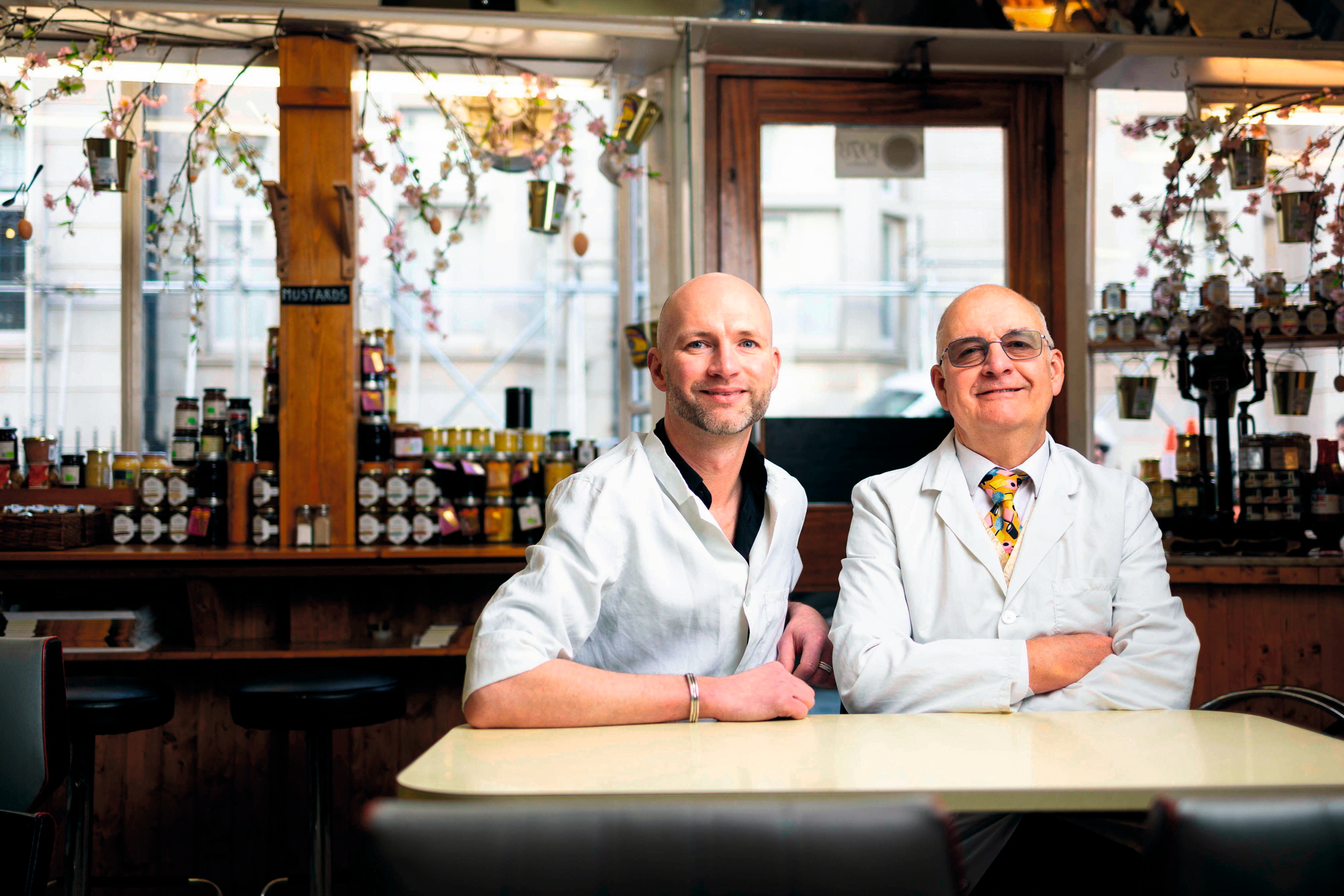A game of two halves — how the sandwich went from humble fare to a country-wide lunchtime obsession
What started life as a way to eat and play cards at the same time (so the story goes) is now the lunch of choice for the working world.


'It's like this from quarter to 12 until about 4pm,’ says Paul Rothe, surveying the hectic scene inside 35, Marylebone Lane, London W1. ‘One minute, there’s nobody around; the next, all hell breaks loose.’
His sandwich shop, the capital’s oldest (established in 1900) and most famous, is a glorious time capsule: Formica-topped tables are arranged cosily under shelves groaning with pickles, mustards and ginger biscuits. At the heart of it is a deli counter, where the Rothe team assembles sandwiches from scratch, to order: if you want a bespoke sarnie, this is the place to come. Can you really have anything you like? ‘We once had a young lady coming in asking for a sardine, pork sausage meat and Branston Pickle sandwich,’ Mr Rothe remembers. ‘I thought she must have taken down an order from her boss and got it wrong — but she came in every day for the rest of the week and had the same sandwich.’ He pauses. ‘I think she might have been pregnant.’
Variations on the sandwich are, of course, eaten all over the world and always have been — but the British, famously, lay claim to its name. According to legend, John Montagu, 4th Earl of Sandwich, instructed his servant to place his roast beef between two slices of bread so he wouldn’t have to break from a game of cards to eat it. ‘I’ll have a Sandwich,’ became the refrain in Clubland in the 1760s — and the rest was history.
The truth might have been a little less sociable: some have argued it’s more likely that Sandwich asked for the dish to be brought to him at his desk at the Admiralty, to keep him going as he dealt with paperwork. ‘The likely truth is that the entire future of the sandwich — its symbiotic relationship with work, its disregard for a slower, more sociable way of eating — was present at its inception,’ author and essayist Sam Knight wrote in The Guardian.
There was certainly nothing leisurely about the ham sandwiches sold at speed (and in quantity: hundreds of thousands a year, according to Victorian social reformer Henry Mayhew) by many dozens of cart-vendors around the capital in the 1850s. Yet, despite being no frills, they were the Holy Grail of a working man’s food: convenient and nutritious.
There was money to be made from them, too. The first Paul Rothe arrived in London from Saxony in 1898, with the aim of bringing a little Continental flair to the trade. As well as ham, he established a tradition of serving home-cooked topside of beef on dense rye bread, all prepared by friendly German-speaking staff. His was a business built on nostalgia, offering a literal taste of home and a reassuring domestic feel: a sandwich, even one you buy out and about, is always made by hand.

It would be a mistake to underestimate the emotional heft of a sandwich. We’ll happily pay double figures for ones that transport us back to a dream of childhood: think of The Goring’s joyously OTT fish-finger creation. The original moveable feast, the sandwich contains a promise of spontaneity—the potential for shrugging off adult responsibilities and rolling up your trouser legs is there, even if you don’t act on it. If you do, it’s almost impossible not to feel like a member of the Famous Five when tucking in somewhere wild and windswept.
Exquisite houses, the beauty of Nature, and how to get the most from your life, straight to your inbox.
Indeed, during the course of writing Jolly Good Food, her Enid Blyton-inspired children’s cook-book, Allegra McEvedy was reminded of the pre-lapsarian pleasures of tomato sandwiches eaten out of greaseproof paper in the fresh air. Blyton’s gang got through gargantuan quantities of them on their adventures: ‘Egg and sardine sandwiches, tomato and lettuce, ham—there seemed no end to them!’ states the record in Five Go to Mystery Moor. (The scale of their consumption required Blyton to use artistic licence: three of her books were written between 1946 and 1948, when bread was rationed in Britain due to low post-war wheat stocks.)
As the 1960s approached, shards of sunshine hit Britain’s sandwich scene. Elizabeth David’s passion for picnics and Mediterranean ingredients converged in her love of the pan bagnat, a Niçoise sandwich made from a hollowed-out loaf stuffed with tuna, egg and tomato. It never really caught on, however, and the now-famous Glen Fairweather photograph of a 1972 Whitehall sandwich bar shows unrefrigerated slabs filled with liver sausage stacked on top of each other on a shelf, their edges curling.
Douglas Adams summed up the mood of the moment when he wrote ‘there is a feeling which persists in England that making a sandwich interesting, attractive, or in any way pleasant to eat is something sinful that only foreigners do’. Beacons of bread-light were the Brass Rail in Selfridges and its salt-beef sandwiches, which were a smash hit from the moment it opened in 1966, and grand hotels such as The Ritz, with its tiered stands of crustless morsels that were and remain the last word in teatime chic.
'Two Mayfair hedgefunders have rolled up their sleeves to get stuck into their salt-beef specials in meditative silence. They’ve even put their phones away: such is the power of a really excellent sandwich'
A sea change came in early 1980, when Marks & Spencer launched a range of triangular white-bread sandwiches in plastic cartons. They were snapped up by workers who were tired of their homemade efforts turning into a slimy mess by lunchtime and we never looked back. As the country as a whole fell under the spell of Nigella Lawson and Jamie Oliver, the high-street sandwich became a vehicle for modish ingredients, many of which had no logical place there — the late A. A. Gill’s bugbear filling was avocado, which he lambasted as having ‘the texture of a smug Mars bar and the flavour of glazing putty’.
Today, for every office building, there seem to be at least two chain sandwich shops, each selling the same selection of underfilled, overpriced offerings. Peering into their chiller cabinets, it’s hard not to feel we’ve barely moved beyond the days of the apocryphal British Rail trick of diagonally folding slices of ham so the sandwiches looked better filled when cut than they actually were.
Yet there is another way, as evidenced by Jermyn Street’s best-kept secret. For the past 15 years, those in the know have been forming a Rothe-esque line every weekday outside Paxton & Whitfield, London SW1, which, as well as being cheesemonger to Buckingham Palace, sells some of the country’s best sandwiches.
‘Often, they’re being snatched from the counter as soon as we’ve made them,’ says Georgia Bullen, one of Paxton’s cheesemongers, who has been making sandwiches for the past two years. ‘People will come in and say, “Ooh, is that a Comté and salami one?” And they take it.’ The selection of four or five seasonal sandwiches, each getting on for the size of a paperback novel, goes out on display at midday and frequently sells out within the hour.
If Paul Rothe’s unique selling point is customisability, Paxton’s is construction. The Jermyn Street sandwiches are based on a wide, flattish, freshly baked sourdough baguette. ‘It’s substantial bread,’ advises Ms Bullen, which keeps everything in; slices of holey sourdough do not a structurally sound sandwich make. The shop also connects shoppers to the waxing and waning of the seasons in a way that city life doesn’t often permit: when I visit, I’m told that the usual goat’s cheese in one sandwich has been swapped for an à point ewe’s-milk one and that the Waterloo (a British brie-style cheese) in the ham one is on spectacular form. You leave a very democratic £6.50 lighter, clutching a balanced, all-in-one meal to enjoy on a bench in St James’s Square.
Back on Marylebone Lane, the line outside Paul Rothe is getting on for Glastonbury levels: the shop, Mr Rothe says wryly, is a casualty of its own ever-expanding range of fillings (‘everyone’s obsessed with chilli now’). ‘We get longer and longer queues because people can’t make their minds up,’ he believes — but it’s all part of the job. ‘We’re here to meet the customers’ requirements.’
Happily, this customer’s requirements are already covered by one of the specials on the chalk board: free-range egg mayonnaise and four — no more, no less — anchovy fillets. ‘That’s the right amount to counteract the richness of the rest of the filling,’ Mr Rothe advises sagely. My order comes between soft, thick slices of granary bread on a plate and I sit at a table to eat it, approaching the endeavour with due reverence. Next to me, two Mayfair hedgefunders have rolled up their sleeves to get stuck into their salt-beef specials in meditative silence. They’ve even put their phones away: such is the power of a really excellent sandwich.

Credit: Melanie Johnson for Country Life
A perfect summer lunch recipe for the long weekend: Spicy udon noodles with tofu and watercress
Melanie Johnson shares a dish which makes the most of cress's peppery punch.
This is how we brew it: The cafés of the Cotswolds
Having lived in the shadow of its Antipodean counterpart, British coffee-shop culture is finally thriving. Ben Lerwill visits the Cotswolds,

Where to find the world's best club sandwich
The club sandwich, arguably the most famous of all sarnies, is a poolside staple, but its origins are tricky to
Emma Hughes lives in London and has spent the past 15 years writing for publications including the Guardian, the Telegraph, the Evening Standard, Waitrose Food, British Vogue and Condé Nast Traveller. Currently Country Life's Acting Assistant Features Editor and its London Life restaurant columnist, if she isn't tapping away at a keyboard she's probably taking something out of the oven (or eating it).
